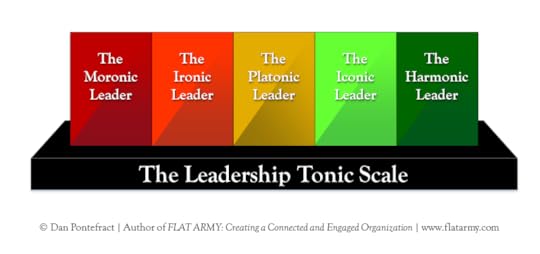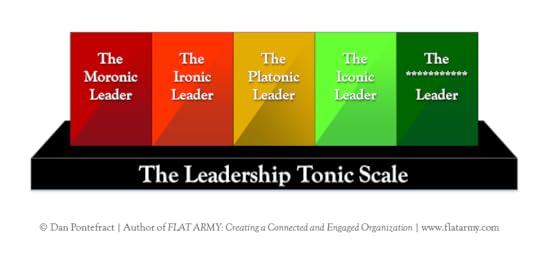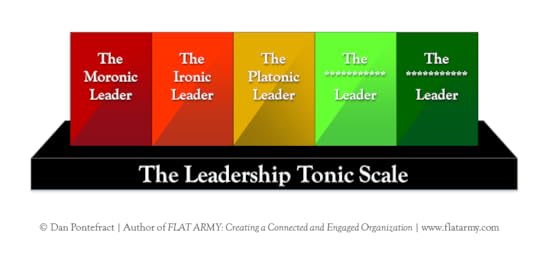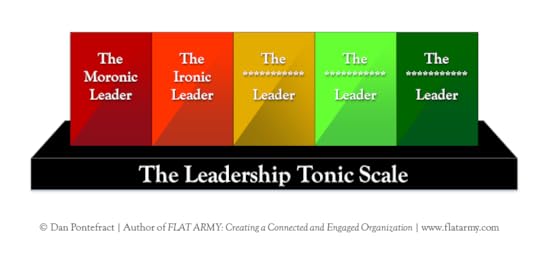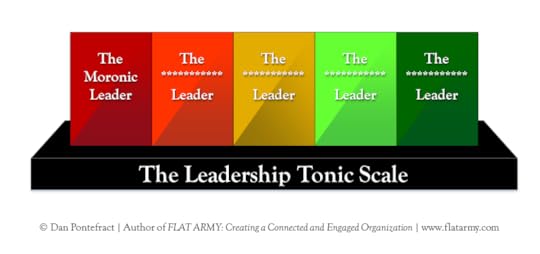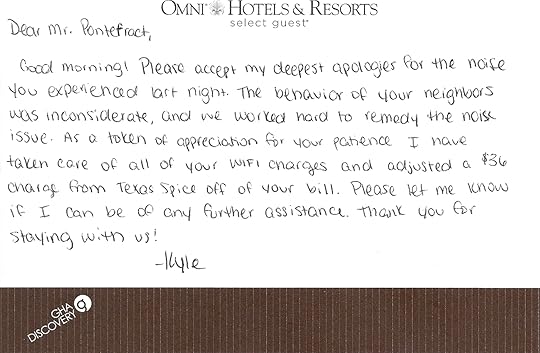Dan Pontefract's Blog, page 48
June 18, 2013
Future Of Work: A Flat Army Of Open Leadership via A.G. Lafley
Flat Army? What the heck is a Flat Army?
Work environments need not feel like a military camp or a ruthless command-and-control operation. The process of work should be fun, innovative, creative and very engaging. I believe that the best way to create a connected and engaged organization is by invoking a “Flat Army” mindset.
Why? Let’s unpack that analogy:
To be flat is to be on a level surface, not in a hierarchy. To be in an army (from armata, the Latin term referenced in 1533, meaning a flotilla of vessels) is to be part of a large group of people who are committed to similar aims or beliefs.
An organization with a Flat Army ethos benefits from an unobstructed flow of coordinated, constructive, creative behaviors that arise from the common interests of employees, leaders, partners and customers. It is a shift from “me” to “we,” using collaborative, participative and growth behaviors. Flat Army is a playbook that moves organizations toward increased engagement and innovation.
Profile Of A Flat Army Leader
In our Flat Army model, a harmonious, connected leader creates a situation where both the team and the leader are as open as possible to performing business tasks and achieving objectives. In an environment where even mundane day-to-day tasks are conducted in this open manner, there is harmony among all contributors, regardless of rank.
Openness — both as a quality of the leader and an expectation of the team — fosters a harmonious relationship among all parties. It’s arguably a step in the right direction towards higher levels of engagement, productivity and business results. A harmonious, open leader connects with the team — parlaying the culture as if it can only be successful when all parties are united, equal in nature and committed to openness. And if we agree that leadership is for all, we also wish that everyone in an organization will participate as a harmonious, open leader.
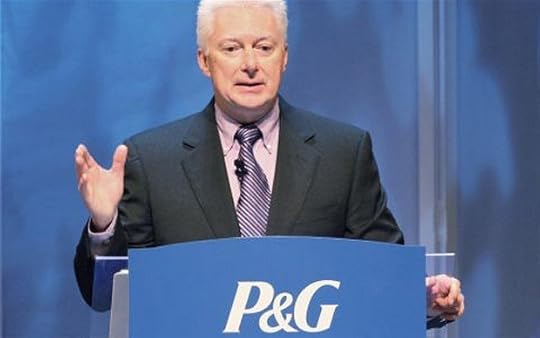 Getting Under The Hood With Open Leaders
Getting Under The Hood With Open LeadersI define open leadership as the act of engaging others to influence and execute a coordinated and harmonious conclusion. Therefore, open leadership is essential for every Flat Army organization.
A.G. Lafley comes to mind when I think of stellar Flat Army leadership. His name may not ring a bell, but I can assure you, he sets a standard of excellence for openness and collaboration. Between 2000 and 2010, Mr. Lafley was the highly successful president and CEO of Procter & Gamble (P&G) — the consumer products conglomerate with over $80 billion in revenue and over 125,000 employees worldwide.
Throughout his decade at the helm, he helped double total sales and quadruple profits, while increasing P&G’s market value by over $100 billion. Furthermore, he helped grow P&G’s portfolio of billion-dollar brands (such as Gillette, Pampers and Tide) from 10 to 24. How did he do it?
In his book The Game Changer: How Every Leader Can Drive Everyday Innovation, co-written with management thought leader, Ram Charan, Lafley refers to the unique relationship between openness and ideas:
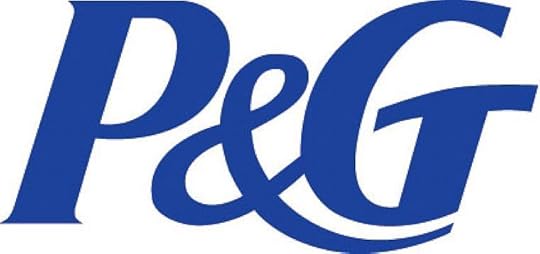
Open architecture is the organizing principle that enables a business and its people to open themselves up to get ideas from anywhere at any time. P&G collaborates with anybody, anywhere, anytime. P&G likes unusual suspects. It will even compete with a company on one side of the street, and cooperate with it on the other. In an open innovation system, anything out there is fair game, even if competitors are sitting on it. And that’s fine with both partners because it works.
At P&G, Lafley opened up everything. He wanted his leaders to be more collaborative, and just as importantly, he wanted his employees to be open. As a results, magic happened. He branded this open architecture “Connect and Develop” or “C&D.” The framework reached across all employees, regardless of title, and it drove not only revenue and profitability, but also employee engagement.
Lafley and Charan explain:
The single characteristic of C&D is the willingness of all people at P&G to be psychologically open and to seriously consider new ideas, whatever the source, thus building a truly open global innovation network that can link up — and be first in line — with the most interesting thinkers and the best products to “reapply with pride.”
Lafley’s leadership example demonstrates what’s possible when a harmonious environment is created through a culture of open initiative. That is Flat Army in action. And perhaps that’s a key reason why P&G just rehired Lafley last month to lead the company forward.
The Open Leader Toolkit
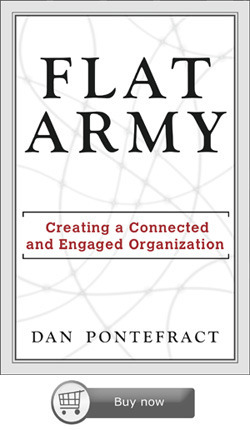 Hopefully now the concept of open leadership is clear. But what are these social business and collaboration tools everyone keeps talking about? An open, Flat Army environment can’t thrive if leaders suffer from technology blindness or ignorance. In truth, tools for communication and collaboration are as integral to a Flat Army mindset as they are to employee engagement and productivity.
Hopefully now the concept of open leadership is clear. But what are these social business and collaboration tools everyone keeps talking about? An open, Flat Army environment can’t thrive if leaders suffer from technology blindness or ignorance. In truth, tools for communication and collaboration are as integral to a Flat Army mindset as they are to employee engagement and productivity.
If your organization doesn’t embrace tools that support dynamic exchange of knowledge and ideas, then be a catalyst for change. Look for ways to integrate capabilities such as blogging, micro-blogging, expert networks, discussion forums, video sharing or instant messaging into existing platforms and workflows. Start using them to demonstrate that you are a connected, collaborative and participative leader who assists your team (and your organization) in achieving their goals and objectives — even as you strive for a high level of employee engagement and customer satisfaction.
What are you doing to help your organization embrace a Flat Army ethos? I invite you to share your ideas and experiences.
Flat Army Leader Examples
Listly by Dan Pontefract
Flat Army Leader Examples
A list of leaders who I believe demonstrate the Flat Army leadership mantra.
55 Views
crowd rank
curated
alpha
Flat Army Graphics on Slideshare
June 15, 2013
Open Leaders: My #TChat Experience
Harvard University of course is in Cambridge, Massachusetts.
Professor Juma tweeted the following on Saturday, which I thought was both poignant and appropriate for the purpose of my pending prose:

Meghan Biro and Kevin Grossman – as they previously state:
“were comparing notes about the many forces reshaping today’s workplace. They wondered aloud about how talent-minded professionals could connect and support one another through chaotic and exciting shifts in business, technology and workforce dynamics.”
Thankfully, in Cambridge, they started up the TalentCulture “world of work” community that includes the highly popular weekly #TChat Twitter chat and #TChat Radio show. With Meghan based in Cambridge and Kevin in Santa Cruz, these two have undoubtedly run into a few enemies as they began TalentCulture, but more importantly, they have created an awe-inspiring collaborative community of professionals desperately yearning for — and in many cases practicing — a new and improved way in which to operate our organizations.
… because we need more Meghan and Kevin’s.
In December of 2008 I joined an organization with an employee engagement level of 53%. I knew it could be turned around if many of us banded together, although I knew I would encounter enemies along the way. In early 2012, I wanted to broaden my reach in an attempt to help others outside of the organization I worked at full-time. So, I sent an email out to 20 people asking for their help. I wanted to write and publish a book even though I knew full well I might create more enemies, whether in the organization I worked at or through the final result of the book itself. The power of my network and my willingness to try something new despite knowing I would create enemies ensured I published the book.
This past week those forces collided. (and what a positive experience it was for me personally)
Earlier in 2013 I was fortunate to be introduced to Meghan and Kevin (and their co-conspirators Kathleen Kruse and Tim McDonald) by one of the brightest interlocutors out there – Nick Kellet – founder of List.ly and one incredibly bright spark. After publishing Flat Army in March in Canada (the USA and Europe followed in April and May) Nick (based in beautiful Kelowna, British Columbia) was kind enough to send a note expressing his sentiments that me (and Flat Army) might be featured through the TalentCulture community.
 And at that point, the #TChat Leadership Train of Meghan, Kevin, Kathleen and Tim was steaming towards me whistling gleefully down the track. Their enthusiasm and willingness to share the Flat Army story of a connected and engaged organization (and leadership style) was maple syrup to my pancakes.
And at that point, the #TChat Leadership Train of Meghan, Kevin, Kathleen and Tim was steaming towards me whistling gleefully down the track. Their enthusiasm and willingness to share the Flat Army story of a connected and engaged organization (and leadership style) was maple syrup to my pancakes.
I know, I’m mixing metaphors.
But trust me, these are very, very good people.
Kathleen effortlessly worked with me on a post for the TalentCulture community
Kevin provided all sorts of guidance and encouragement
Tim recorded a Google+ Hangout with me (and offered me tips for my own timeslot)
Meghan wrote a post for Forbes linking to our theme for the week and interviewed me for a 30-minute TChat Radio segment
Of course everything culminated with me moderating the #TChat Tweetstorm for 60 minutes where it landed on the Top 10 Twitter Trending list in the USA during its Wednesday timeslot.
Meghan has taken the final step of recapping the entire week of ‘open leadership’ in a masterfully written summary. (ie. no point in trying to duplicate excellence)
To the entire team, my many thanks. Not simply for inviting me as a guest, but for what you are doing to help hundreds of professionals get on the ‘open leadership’ bus. You are open leaders … you are role models for many to look up to.
I’m glad you tried something new despite potential enemies in your midst.
So many people out there are better off as a result of your courage and openness.
#kudos #tchat … You are #openleaders
159 total views, 159 views today
Related Posts:WHY I Wrote Flat Army: The Flat Army Golden CircleThe Harmonic Leader: Stage 5 of 5 in the Leadership Tonic…Don’t Be a FOOL: Fear of Open LeadershipMy Network is my Net Worth – Part IIAn Example of the Flat Army CLAM in Action: BC Ideas2Action
June 14, 2013
IF
“We’re not here to see through each other; we’re here to see each other through.”
_____________________
IF
IF you can keep your head when all about you
Are losing theirs and blaming it on you,
If you can trust yourself when all men doubt you,
But make allowance for their doubting too;
If you can wait and not be tired by waiting,
Or being lied about, don’t deal in lies,
Or being hated, don’t give way to hating,
And yet don’t look too good, nor talk too wise:
If you can dream – and not make dreams your master;
If you can think – and not make thoughts your aim;
If you can meet with Triumph and Disaster
And treat those two impostors just the same;
If you can bear to hear the truth you’ve spoken
Twisted by knaves to make a trap for fools,
Or watch the things you gave your life to, broken,
And stoop and build ‘em up with worn-out tools:
If you can make one heap of all your winnings
And risk it on one turn of pitch-and-toss,
And lose, and start again at your beginnings
And never breathe a word about your loss;
If you can force your heart and nerve and sinew
To serve your turn long after they are gone,
And so hold on when there is nothing in you
Except the Will which says to them: ‘Hold on!’
If you can talk with crowds and keep your virtue,
‘ Or walk with Kings – nor lose the common touch,
if neither foes nor loving friends can hurt you,
If all men count with you, but none too much;
If you can fill the unforgiving minute
With sixty seconds’ worth of distance run,
Yours is the Earth and everything that’s in it,
And – which is more – you’ll be a Man, my son!
– Rudyard Kipling
249 total views, 5 views today
Related Posts:For Don …I Have Never Worn a WatchI Unfriended You On Facebook. Are We Still Friends?Flat Army DedicationLive the Dream First of Learning & Enterprise 2.0
June 10, 2013
The Leadership Tonic Scale – Free PDF Download
 During the week of June 3, I wrote five posts in five days centered on “The Leadership Tonic Scale”.
During the week of June 3, I wrote five posts in five days centered on “The Leadership Tonic Scale”.
I defined five types of leadership styles found in organizations today:
The Moronic Leader
The Ironic Leader
The Platonic Leader
The Iconic Leader
The Harmonic Leader
You can download the entire series as a singular PDF document.
Download PDF Version of The Leadership Tonic Scale
Thanks for visiting, downloading and/or reading.
cheers
dp
The Leadership Tonic Scale by Dan Pontefract
441 total views, 85 views today
Related Posts:The Iconic Leader: Stage 4 of 5 in the Leadership Tonic…The Ironic Leader: Stage 2 of 5 in the Leadership Tonic…The Platonic Leader: Stage 3 of 5 in the Leadership Tonic…The Moronic Leader: Stage 1 of 5 in the Leadership Tonic…The Harmonic Leader: Stage 5 of 5 in the Leadership Tonic…
June 7, 2013
The Harmonic Leader: Stage 5 of 5 in the Leadership Tonic Scale
The Leadership Tonic Scale identifies and defines five types of leadership styles found in today’s organization. This is the fifth of those five types.
The Harmonic Leader
In my book Flat Army: Creating a Connected and Engaged Organization I highlight a scenario I call “Crossing the Leadership Chasm” where a leader must successfully open herself up to the team/organization and the team/organization has to open themselves up to the leader. If this occurs — where both sides are operating in an open and thus harmonious manner — we can define her as a Harmonic Leader. That is, there is harmony between all players.
In the Spring of 2013 something very interesting occurred. After a four-year absence (and retirement) A.G. Lafley returned to the post of CEO and Chairperson of Procter & Gamble — a post he held between 2000 and 2009 — to reinvigorate what can only be described as a negatively spiraling future at the 175 year-old company.
I find A.G. Lafley to be the perfect definition of a Harmonic Leader. I’m not surprised at all he has resurfaced.
As I detailed in Flat Army:
Through his decade at the ultimate leadership helm he helped to double total sales, quadrupled profits while increasing P&G’s market value by over $100 billion dollars. Furthermore he helped grow the number of billion-dollar brands at P&G – such as Gillette, Pampers, and Tide – from 10 to 24. How’d he do it? In his book, “The Game Changer: How Every Leader Can Drive Everyday Innovation (Profile Books, 2008) co-written with thought leader Ram Charan, Lafley refers to the unique combination of openness and ideas.
They write:
“Open architecture is the organizing principle that enables a business and its people to open themselves up to get ideas from anywhere at anytime. P&G collaborates with anybody, anywhere, anytime. P&G likes unusual suspects. It will even compete with a company on one side of the street, and cooperate with it on the other. In an open innovation system, anything out there is fair game, even if competitors are sitting on it. And that’s fine with both partners because it works.”
At P&G, Lafley opened up everything. He wanted his leaders to be more open and equally important he wanted his employees to be open. When that occurred, magic happened. He branded this open architecture at P&G “Connect and Develop” or C&D for short. It was an open leadership framework that ran across all employees, regardless of title, and it not only drove revenue and profitability, it grew employee engagement.
Lafley and Charan further opine:
The single characteristic of C&D is the willingness of all people at P&G to be psychologically open and to seriously consider new ideas, whatever the source, thus building a truly open, truly global innovation network that can link up—and be first in line—with the most interesting thinkers and the best products to “reapply with pride.”
To be a Harmonic Leader both the team and the leader need to be open, trusting and collaborative. The leader must be eager to listen to the people of the organization in order to drive the business forward. When a crisis occurs, command and control ruling isn’t immaturely inserted into the leader’s bag of behaviour tricks. She remains open, trusting and collaborative.
What More to Know:
What more is there to know? This is the ideal leadership style, one you want to be aligned to and one you want to embrace yourself.
It’s form before function, and behaviour before technology; the Harmonic Leader knows it’s about an open, trusting and collaborative behaviour before anything else including fancy social technologies.
Read Flat Army … it’s packed with details that directly align to the concept of the Harmonic Leader.
My suspicion is A.G. Lafley was brought back to P&G not only for his business acumen … but to reinstate a sense of openness and connectedness that might have diminished since his departure. I am very curious to see how this next chapter of P&G — and A.G. Lafley — plays out over the coming months and quarters. I’m very interested to see if A.G. continues to be the Harmonic Leader in the current state of crisis at P&G.
I’m very interested to see every leader become a Harmonic Leader in today’s organizations.
NB: although I didn’t include the Leadership Tonic Scale in my book Flat Army: Creating a Connected and Engaged Organization, you may be interested in Chapters 4-6 (The Connected Leader) and Chapter 7 (The Participative Leader Framework) in particular as they help to depict what I believe are the key ingredients to 21st century leadership. The entire Leadership Tonic Scale will be released on June 10th as a free downloadable paper.
316 total views, 312 views today
Related Posts:The Iconic Leader: Stage 4 of 5 in the Leadership Tonic…The Moronic Leader: Stage 1 of 5 in the Leadership Tonic…The Platonic Leader: Stage 3 of 5 in the Leadership Tonic…The Ironic Leader: Stage 2 of 5 in the Leadership Tonic…Don’t Be a FOOL: Fear of Open Leadership
June 6, 2013
The Iconic Leader: Stage 4 of 5 in the Leadership Tonic Scale
The Leadership Tonic Scale identifies and defines five types of leadership styles found in today’s organization. This is the fourth of those five types. Come back and visit each day during the week of June 3, 2013 to find out the next leadership type as depicted in the Leadership Tonic Scale.
The Iconic Leader
The Iconic Leader is a gem, and one notch away from our final leader definition on the Leadership Tonic Scale. What is an icon? In this case we’re not referring to religious paintings as it was first defined. Typically in our modern day we think of icons as those who have demonstrated excellence over a period of time. There are sporting icons, author icons, acting icons … and of course there are leadership icons. Thus, if we want to achieve the final stage of the Leadership Tonic Scale, we must assess what makes leadership icons iconic.
Iconic leadership is not about perfection. As Winston Churchill once said (an example of Iconic Leadership) “To improve is to change; to be perfect is to change often.” It is about the repeatable and demonstrable act of delivering on your actions such that we mere mortals can learn from the consistent behaviour they have maintained. The aforementioned Churchill taught us about resiliency, Gandhi taught us compassion, Mother Theresa demonstrated humility, Steve Jobs was uber innovative (despite other flaws mentioned earlier) and Hillary Clinton was and is both patient and a tireless negotiator.
What More to Know:
Don’t set your sights on becoming an Iconic Leader – that’s something a Moronic Leader would do
Start reading autobiographies and glean what you can from those that have changed the world but don’t limit yourself to a singular genre
Cherry pick some of the traits, skills and behaviours that are suitable to your situation and career path and try to embed into your own leadership style over time
An icon that changed the game of authoring — and in particular educating her audience, young children, to think differently — was Astrid Lindgren. Pippi Longstocking, the character she brought to life in 1945 with equal parts untidiness, cleverness, noisiness, independence and creativity encouraged children to think differently, to explore and to seek out adventure and freedom. Back in the day it was radical. But that’s what we should be drawing upon as we analyze (and mentally ingest) the characteristics of an Iconic Leader.
NB: the Leadership Tonic Scale does get better from here. What’s the next stage? Although I didn’t include the Leadership Tonic Scale in my book Flat Army: Creating a Connected and Engaged Organization, you may be interested in Chapters 4-6 (The Connected Leader) and Chapter 7 (The Participative Leader Framework) in particular as they help to depict what I believe are the key ingredients to 21st century leadership. The entire Leadership Tonic Scale will be released on June 10th as a free downloadable paper.
162 total views, 158 views today
Related Posts:The Moronic Leader: Stage 1 of 5 in the Leadership Tonic…The Platonic Leader: Stage 3 of 5 in the Leadership Tonic…The Ironic Leader: Stage 2 of 5 in the Leadership Tonic…Friday Fun: You Don’t Have an Office?10 Free Copies of Flat Army … Participate to Win
June 5, 2013
The Platonic Leader: Stage 3 of 5 in the Leadership Tonic Scale
The Leadership Tonic Scale identifies and defines five types of leadership styles found in today’s organization. This is the third of those five types. Come back and visit each day during the week of June 3, 2013 to find out the next leadership type as depicted in the Leadership Tonic Scale.
The Platonic Leader
I know, your first thought is, “wait … shouldn’t all leaders behave in platonic ways otherwise HR gets overburdened with harassment complaints and Finance has to start cutting an inordinate number of severance cheques?” Well ya, but my definition of a Platonic Leader is not about sex in the office. It’s about those leaders who are in fact pretty successful in their role but they shy away from — you might say shun — any trait whatsoever that demonstrates friendliness, compassion and/or caring for their team members.
The Platonic Leader gets the job done but does so not necessarily caring about the feelings of those he has bull-dozed to accomplish the goal, be it his own employees or those from other parts of the organization. It’s a bit like Russia’s Vladimir Putin in his eternal quest to remain in power. Or better yet, (blasphemous as it may be) perhaps it’s like Steve Jobs who would publicly berate team members if products were not to his liking and who was alleged to have micro-managed a project to achieve his vision without a care for the hearts and minds he bowled over in his perfection journey.
The Platonic Leader is a cardboard cut-out. Many senior leaders will look for the Platonic Leader to lead particular posts in an organization as they are often viewed to get the job done no matter the cost. They live by words such as, “we can do more with less” or “we’re eating our own dog food” or “it’s like putting lipstick on a pig” or “it’s not rocket science stupid.” In other words, they’re a bit robotic but effective.
What More to Know:
They are good people, sadly they are a tad clueless when it comes to emotional intelligence
Reach out to them and help them see what might transpire if they balanced a results driven personality with a sprinkling of compassion and employee engagement (suggest a coach)
Begin some of your conversations asking about their weekend, current events or even bring up your own personal situation and see if you steer the leaders towards a lighter side
Don’t have sex with the leader. (Do you remember Lewinsky?) That’s going a tad too far. Platonic leaders simply need a whack on the head to help them understand business intelligence is nothing unless there is personnel intelligence as well. They have to become less of a cardboard cut-out and more like the combination of Dorothy, the Cowardly Lion, the Tin Woodman and the Scarecrow – a well-rounded openly communicative and collaborative human being.
NB: the Leadership Tonic Scale does get better from here. What’s the next stage? Although I didn’t include the Leadership Tonic Scale in my book Flat Army: Creating a Connected and Engaged Organization, you may be interested in Chapters 4-6 (The Connected Leader) and Chapter 7 (The Participative Leader Framework) in particular as they help to depict what I believe are the key ingredients to 21st century leadership. The entire Leadership Tonic Scale will be released on June 10th as a free downloadable paper.
155 total views, 152 views today
Related Posts:The Moronic Leader: Stage 1 of 5 in the Leadership Tonic…The Ironic Leader: Stage 2 of 5 in the Leadership Tonic…Friday Fun: You Don’t Have an Office?10 Free Copies of Flat Army … Participate to WinDon’t Be a FOOL: Fear of Open Leadership
June 4, 2013
The Ironic Leader: Stage 2 of 5 in the Leadership Tonic Scale
The Leadership Tonic Scale identifies and defines five types of leadership styles found in today’s organization. This is the second of those five types. Come back and visit each day during the week of June 3, 2013 to find out the next leadership type as depicted in the Leadership Tonic Scale.
The Ironic Leader
The ‘Ironic Leader’ lives a leadership life of irony. Of course many people confuse coincidence with irony, but this is no coincidence. Ironical, isn’t it? Irony stems from the Greek word ‘eironeia’ which was defined as simulated ignorance. That about sums up the definition of the Ironic Leader; it’s someone who simultaneously ignores her team whilst conveying the exact opposite of what she is purporting. It’s like a dog owner is saying ‘sit’ to her dog yet the dog is deaf and the owner actually wants the dog to go for a walk.
The Ironic Leader is an ATNA — all talk no action — where she talks up a good game to the team but never actually accomplishes anything or remembers what she said in the first place. You’ve heard of ‘paralysis by analysis’? This is the epitome of our Ironic Leader. She analyzes everything until everyone’s eyes start bleeding only to succumb to a time bomb going off that destroys the project. It reminds me of certain leaders at XEROX during the heyday of the PARC lab who sat on a goldmine with the invention of the mouse and the graphical user interface (GUI) only to see others (like Apple) swoop in and buy/steal the original idea. Ironic Leaders say one thing and do another.
It’s a bit like Jay Leno. (ask Conan O’Brien)
Imagine being told in 2004 that you would host The Tonight Show (as Conan was told) in 2009. Both Jeff Zucker (the NBC executive orchestrating the career development paths of Jay Leno and Conan O’Brien) and Jay Leno agreed to such a plan. Once Conan assumed the mantle of The Tonight Show, his tenure was about as long as the reign of King Edward VIII although only one of the two actually abdicated his role. (guess which one?) Both Zucker and Leno acted like Ironic Leaders; they both said one thing and when things didn’t go their way, immaturity, a coward DNA and gutlessness set in and O’Brien got the shaft.
What More to Know:
Their words are translucent; gain assurance from them on your deliverables, deadlines, etc.
Set the tone, the agenda and the playbook. Be proactive and take charge.
Dithering leaders need a carefully orchestrated punt in the backside; figure out how to deliver it without getting fired.
Ironic Leaders are a step up from the Moronic Leader but they can be equally if not more frustrating. They mean well (unlike a Moronic Leader) but can’t figure out how to run to first base after cracking their bat. They may even get tossed from the batter’s box because they took too long to get ready. Wait, didn’t they say they hated baseball? How ironic!
NB: the Leadership Tonic Scale does get better from here. What’s the next stage? Although I didn’t include the Leadership Tonic Scale in my book Flat Army: Creating a Connected and Engaged Organization, you may be interested in Chapters 4-6 (The Connected Leader) and Chapter 7 (The Participative Leader Framework) in particular as they help to depict what I believe are the key ingredients to 21st century leadership. The entire Leadership Tonic Scale will be released on June 10th as a free downloadable paper.
306 total views, 303 views today
Related Posts:The Moronic Leader: Stage 1 of 5 in the Leadership Tonic…Friday Fun: You Don’t Have an Office?10 Free Copies of Flat Army … Participate to WinDon’t Be a FOOL: Fear of Open LeadershipHas the Economic Meltdown & 9/11 Impacted our…
June 3, 2013
The Moronic Leader: Stage 1 of 5 in the Leadership Tonic Scale
The Leadership Tonic Scale identifies and defines five types of leadership styles found in today’s organization. This is the first of those five types. Come back and visit each day during the week of June 3, 2013 to find out the next leadership type as depicted in the Leadership Tonic Scale.
The Moronic Leader
The ‘Moronic Leader’ is the bottom feeder of the Leadership Tonic Scale.
He believes ruthless command and control tactics are the basis in which to lead. He insists on perfection and micro-manages the actions and deliverables of his team at all times with equal parts vigor and insanity. When errors occur, team members are reprimanded whether privately or publicly in front of colleagues. Actual lashings may be utilized. When efforts from the team exceed expectations or targets, the moronic leader takes credit for the result and forges a letter from a customer outlining how fabulous his actions were. He of course delivers the letter to the CEO.
The Moronic Leader believes the only way to get results is to bully. “Cracking the Whip” doesn’t seem to be a simile; it’s the real deal. Workplace stress is encouraged, exacerbated by daily demands far exceeding the definition of humanity. The verbal and mental abuse a Moronic Leader invokes on what he refers to as “my subordinate minions” is the very definition of workplace hell.
‘Emotional Intelligence‘ is incomprehensible to the moronic leader. In fact, he thinks it’s the title of a Hollywood blockbuster movie starring Matt Damon or Tom Cruise. Knowing the likes, dislikes or hobbies of his team is as likely as him recognizing employees for a job well done. Recognition usually involves a mirror with the Moronic Leader being the only human (is he really human?) in the mirror itself. Being collaborative and using social tools to open up and/or connect with employees only occurs when North and South Korea military personnel agree to moonlight dancing in the DMZ.
What More to Know:
Run away
Tap into your network and seek out a new job or role
Pray someone in HR has figured out this goofball needs to be terminated and replaced with Watson, R2-D2 or iRobot
The Moronic Leader is as set in his ways as is United Airlines’ quest to break guitars or whoever is in charge of your local Taylorism fan-club. It is irreversible. You need to find yourself a new career home. Instill some gumption into your DNA and take flight immediately. If you recognize a colleague or friend in this situation, do the right thing and help him or her get out of the role ASAP.
NB: the Leadership Tonic Scale does get better from here. What’s the next stage? Although I didn’t include the Leadership Tonic Scale in my book Flat Army: Creating a Connected and Engaged Organization, you may be interested in Chapters 4-6 (The Connected Leader) and Chapter 7 (The Participative Leader Framework) in particular as they help to depict what I believe are the key ingredients to 21st century leadership. The entire Leadership Tonic Scale will be released on June 10th as a free downloadable paper.
569 total views, 4 views today
Related Posts:Friday Fun: You Don’t Have an Office?10 Free Copies of Flat Army … Participate to WinDon’t Be a FOOL: Fear of Open Leadershipthe FLAT ARMY cheat sheetThe Mysterium Tremendum Leader
May 31, 2013
Omni Hotels & Resorts in Dallas Demonstrate Great Customer Service
When I travel on business there are a few hotel conditions I live by:
Don’t pick a hotel that was once a brothel
Stay away from hotels that charge “by the hour”
Ensure there are windows
Hotels that offer ‘Happy Hour’ (but from 6pm – 2am) are generally to be avoided
I was in Dallas, Texas recently and as I was speaking at the ASTD International Conventional and Exhibition Conference I chose to stay at the Omni Hotels & Resorts Dallas hotel – located adjacent to the Dallas Convention Center.
It’s a splendid hotel devoid of any of the bullets above. (it’s also devoid of bullets)
My flight back to Vancouver was slated for 7am. Naturally, being the time management nutbar that I am, I was in bed at 10pm with a wake-up call set for 5:15am so I could shower and head off to the airport to catch the flight.
At 2am the orchestral movement in the dark of high-pitched hyena-like laughing began from the room next door. My semi-catatonic // semi-conscious state presumed it was a dream but it ensued for the next 10 minutes. That’s when I took action. Yup, I began hitting the hotel wall presuming my thuds would be an inclination of displeasure.
It wasn’t.
I’m pretty sure they were snorting cocaine.
So, after another 10 minutes of Canadian patience I called down to the front-desk and explained the situation. I don’t recall the woman’s name I spoke with but she said not to worry and that it would be handled.
I found some earplugs from my bag, put them in to soften the hyena yelping down to a lower pitch, and I tried to go back to sleep.
When the phone rang at 5:15am, I got up, had my shower and with my trusty bag already packed, proceeded to exit the room on to a waiting taxi for the ride to the airport.
But what did I see under the hotel room door? The graphic below explains things rather nicely:
To Kyle – the night manager of Omni Hotels and Resorts in Dallas – you (and your team) should be recognized for the reassuring way in which you handled the situation (I presume you didn’t shoot the hyenas next door) as well as your Customers First approach to make me feel better about the inconvenience.
It wasn’t your fault, but you took responsibility which is certainly above and beyond the call of duty.
Thank you for an exemplary case study of customer service leadership.
206 total views, 206 views today
Related Posts:Friday Fun: The Difference b/t Apple & Microsoft Is…Air Canada Isn’t Collaborating With Its EmployeesWhy Don’t We Tip Flight Attendants?Review: SharePoint Conference 2011Flexible Working Works


